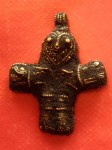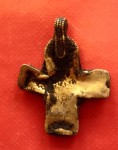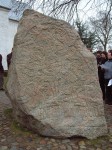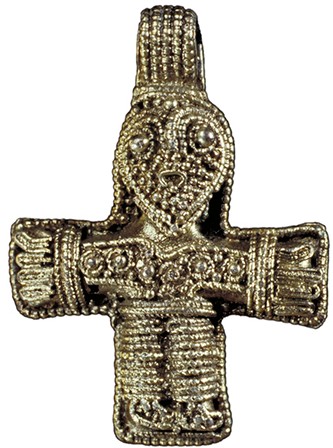Landscape gardener Dennis Fabricius Holm picked up his first metal detector just two and a half months ago. It was his son’s, a Christmas present he’d gotten years before and never used. Holm fished it out of the basement and took it to the empty field next door to his home in the village of Aunslev on the Danish island of Funen to do a few hours of scanning every Friday afternoon. He found some buttons and small coins, nothing to write home about.

 Last Friday, March 11th, Holm found something to write history books about. In an area of the field he hadn’t scanned before, his machine alerted him to a metallic object not made of iron. A mere four inches under the surface he found a little gold pendant 3.5 centimeters (1.4 inches) wide and 4 centimeters (1.6 inches) high, weighing 14 grams. The artifact’s fine filigree showed through the caked dirt. Excited about his find, Holm posted pictures of it on a Facebook page for Danish metal detector enthusiasts and was quickly deluged with congratulations.
Last Friday, March 11th, Holm found something to write history books about. In an area of the field he hadn’t scanned before, his machine alerted him to a metallic object not made of iron. A mere four inches under the surface he found a little gold pendant 3.5 centimeters (1.4 inches) wide and 4 centimeters (1.6 inches) high, weighing 14 grams. The artifact’s fine filigree showed through the caked dirt. Excited about his find, Holm posted pictures of it on a Facebook page for Danish metal detector enthusiasts and was quickly deluged with congratulations.
 He contacted Malene Refshauge Beck, an archaeologist and curator at the East Funen Museums, who identified it as a crucifix from the first half of the 10th century. That makes it the oldest figure of Christ ever discovered in Denmark. Before this find, the Christ figure engraved on the largest Jelling Stone, a massive runestone raised by Harald Bluetooth in around 965 A.D., was the oldest known in Denmark. It was a fitting record for a stone whose runic inscription reads: “King Harald bade this monument be made in memory of Gorm his father and Thyra his mother, that Harald who won for himself all Denmark and Norway and made the Danes Christians.”
He contacted Malene Refshauge Beck, an archaeologist and curator at the East Funen Museums, who identified it as a crucifix from the first half of the 10th century. That makes it the oldest figure of Christ ever discovered in Denmark. Before this find, the Christ figure engraved on the largest Jelling Stone, a massive runestone raised by Harald Bluetooth in around 965 A.D., was the oldest known in Denmark. It was a fitting record for a stone whose runic inscription reads: “King Harald bade this monument be made in memory of Gorm his father and Thyra his mother, that Harald who won for himself all Denmark and Norway and made the Danes Christians.”
 The pendant could be dated with such precision because it is almost identical to a pendant found in Sweden. The first crucifix of this design was unearthed in 1879 from grave 660 in a Viking cemetery at Birka, an 8th century town about 20 miles west of Stockholm. The earliest Christian missionaries who went to Sweden in the 9th century were centered in Birka. The town was destroyed in the 10th century and never rebuilt. Its ruins were rediscovered by an entomologist, Hjalmar Stolpe, who was there to study ancient insects trapped in amber. When he found large quantities of non-native amber on the island, he realized it must have once been an important trading center and so began archaeological excavations that would continue for almost 25 years, from 1871 through 1895.
The pendant could be dated with such precision because it is almost identical to a pendant found in Sweden. The first crucifix of this design was unearthed in 1879 from grave 660 in a Viking cemetery at Birka, an 8th century town about 20 miles west of Stockholm. The earliest Christian missionaries who went to Sweden in the 9th century were centered in Birka. The town was destroyed in the 10th century and never rebuilt. Its ruins were rediscovered by an entomologist, Hjalmar Stolpe, who was there to study ancient insects trapped in amber. When he found large quantities of non-native amber on the island, he realized it must have once been an important trading center and so began archaeological excavations that would continue for almost 25 years, from 1871 through 1895.
A fragmentary second crucifix of the Birka type has survived. Their designs are so similar that archaeologists believe they were made by the same craftsman. East Funen Museums archaeologists will now contact their counterparts at the Swedish History Museum in Stockholm, where the original Birka crucifix is kept. The two crosses will be compared to determine whether they were made by the same hand.
 The Aunslev crucifix is the most precious of the three. The first Birka crucifix is gilded silver with much of the gilding worn off. The fragmentary second one is silver. Holm’s find is solid gold. The goldsmith shaped a thin gold wire in parallel lines and small balls called granulation. It would have been a very expensive piece, likely worn by a woman.
The Aunslev crucifix is the most precious of the three. The first Birka crucifix is gilded silver with much of the gilding worn off. The fragmentary second one is silver. Holm’s find is solid gold. The goldsmith shaped a thin gold wire in parallel lines and small balls called granulation. It would have been a very expensive piece, likely worn by a woman.
 Christianity was introduced to Denmark via the elite so this pendant probably belonged to someone wealthy and influential. Whether that person was Christian is impossible to know since the piece was found in a field, not in a grave like the others. Wearing a crucifix could be advantageous when dealing with the already Christianized peoples south of Denmark, and even if the wearer did espouse Christian beliefs, at this stage the new faith often coexisted with the traditional one of Thor and Odin. Indeed, Christ’s expression on the crucifix is not the one of a suffering man near death, but rather of a fearless warrior akin to the Norse heroes and deities.
Christianity was introduced to Denmark via the elite so this pendant probably belonged to someone wealthy and influential. Whether that person was Christian is impossible to know since the piece was found in a field, not in a grave like the others. Wearing a crucifix could be advantageous when dealing with the already Christianized peoples south of Denmark, and even if the wearer did espouse Christian beliefs, at this stage the new faith often coexisted with the traditional one of Thor and Odin. Indeed, Christ’s expression on the crucifix is not the one of a suffering man near death, but rather of a fearless warrior akin to the Norse heroes and deities.
The pendant is now at the Viking Museum in Ladby where it will be cleaned and conserved. It will be put on display this summer.